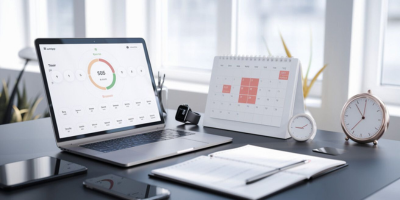To maintain employee productivity in modern workplaces, today’s managers must adopt a careful and balanced approach, akin to fine-tuning an engine. Having worked with both in-store and remote teams, I’ve learned that smart monitoring not only helps with revealing the structure beneath the confusion but also transforms chaos into clarity. People-focused solutions yield the deepest impact. In this article, I aim to provide insights on measuring productivity for 2025 and beyond while keeping team engagement high and goals straight. For more information, check out this detailed guide to the Controlio app.
Work Focus Over Hours Worked
The hour-based attendance system is now meaningless; in the year 2025, what matters is goal achievement. During my stint with an advertising agency, we stopped tracking work hours and shifted to measuring completed campaigns, which led to employee satisfaction and an increase in campaign completion. A 2024 research study noted that focusing on metrics related to engagement boosted productivity by 22%.
The Controlio app, a type of tracking software, can assist you in tracking milestones and customer satisfaction. Furthermore, it is essential for any business to set precise targets that center around key performance indicators, using CA, or customer acquisition, as a main focus. Define the specific key performance indicators that drive success within your business, like proactive sales engagements.
Use Technology to Track Productivity
The latest comprehensive monitoring strategies recommend automating processes to enhance precision. Modern tools enable monitoring of email and task completion without any active participation. Recently, I worked on a freelance task where utilizing tracking software revealed that I was overly consumed by emails. When I changed my email usage, it helped in habit formation and saved multiple hours per week.
Software that provides real-time analytics should be prioritized, for example, the Controlio app. Moreover, automated meeting overviews flag meetings that are set but have no clear objectives. A 2023 report noted that automated tracking reduces administrative workload by 15%.
Encourage Openness and Constructive Engagement
Too much email, attending excessive unnecessary meetings, and schedule conflicts—all common grievances shared with me by remote workers. Significantly improving remote work hygiene hinges on coherent, employee-friendly monitoring policies designed to foster a collaborative and self-improvement culture. In a survey done in 2024, 68% of the global workforce agreed employees should partake in monitoring when there is clarity.
A detailed outline should focus on what specifics are tracked—keystrokes, task progress, or app usage—and how they are used afterward. Ensure that the processes avoid silently logging keystrokes. Together with enforcing boundaries, this fortifies the monitoring as supportive.
Balance Quantitative and Qualitative Metrics
Metrics and numbers only depict a portion of the reality. Creativity misses out if all that is considered are hours spent on tasks. During my retail days, I noticed that some employees excelled at what we termed “customer problem solving” yet had low task completion counts. A better approach would be to assess task completion and client assessment scores to get a more holistic view.
Your tracking tool can easily measure these metrics along with others like monthly deadlines or peer assessment. This method is solid due to the Controlio app’s customizable reports. Such reports ensure that you are not just checking boxes but truly recognizing meaningful contributions.
Support Employee Well-Being
If a team is productive, but employees feel drained at an initiative, then productivity is in decline. Monitoring, such as lack of breaks or extended hours, can signal work overload. In one of my community-led projects, the data showed that a volunteer was trying to compensate for lack of engagement from their peers, which obviously didn’t occur. Realigning some responsibilities improved performance dramatically. Gallup revealed in their 2024 survey that turnover is reduced by an astounding 30% when businesses focus on employee well-being.
Use these guidelines to promote rest, balance, and somewhat manageable expectations leaning toward the minimal side. These tools can enable schedules that promote greater balance by measuring focused work and attention diversion. A happy workplace is marked by enhanced productivity.
Adapting to Hybrid and Remote Work Models
As hybrid and remote working models become a fixture, approaches to monitoring progress need a rethink. They have to balance tracking productivity without micromanaging, Pavlovian-style. I saw this with my team as we transitioned to a hybrid work model; analyzing “in-office” and “remote” outputs showed that flexible working policies resulted in increased productivity and focus. Gartner estimates that 70% of organizations will leverage monitoring tools to supervise distributed teams by 2026.
Locational employee insights, meeting-to-minute analysis, and many others are useful features to look for in software. For example, the Controlio app will highlight productivity hotspots within your team, which allows you to structure their work arrangements for optimal efficiency.
Final Note: Monitor to Empower, Not Overwhelm
Empowering and energizing your team while assessing productivity metrics in 2025 allows for freedom to innovate. Achieving targeted results while leveraging tech, trust, balanced metrics, robust well-being support, and suggesting a hybrid model makes trusting policy adaptations easier. The Controlio app and similar tools can help, but workplace culture is set by leadership, which means your control is much more prompt. What is one tangible action you’re taking to optimize your team’s productivity in 2025? Share your ideas; I’d love to hear your approach!

